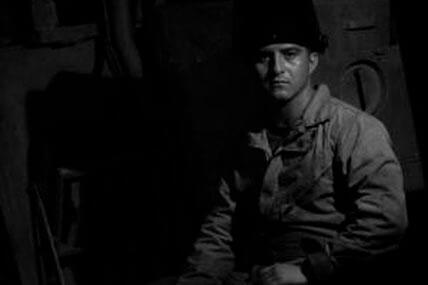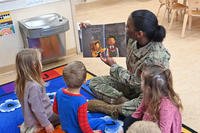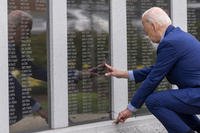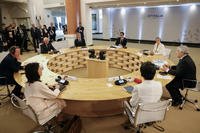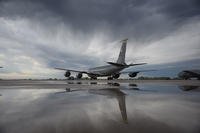USS HARPERS FERRY - It is Sept. 4, 2013 on the Pacific Ocean. Temperatures are peaking in the mid 80’s, humidity is very high. Aboard USS Harpers Ferry (LSD 49), it feels extra hot and muggy inside the well deck, a large hollow chamber built to hold vehicles, vessels and cargo for amphibious operations.
Toward the back of the well deck, remains a lone amphibious assault vehicle 7, separated from the others. Small streaks of turquoise light shoot from underneath the massive green armored personnel carrier. A walk to the other side reveals a Marine lying on his back welding aluminum together.
Cpl. Jose I. Navarrette serves 13th Marine Expeditionary Unit as a metal worker with Combat Logistics Battalion 13, during its 2013 Western Pacific Deployment. He is the only Marine welder aboard the Harpers Ferry, however he serves with distinction in many, many other ways as part of an AAV-R7 crew.
His main expertise is two-fold; first as a welder and second as a machinist. Welding is the repairing of breaks, replacing of plates and the fusion of metal under extreme temperatures. While machining is the fabricating or repairing of parts or components, including frames or modifications.
Born in Guatemala, he moved to the U.S. with this family when he was six and spent most of his youth in Hayward, Calif., a town outside San Jose. After spending a short time working as an accountant, he decided he wanted to better himself and joined the Marine Corps January 2010. Upon graduation he went to occupational school at Ft. Lee, Va. to learn his trade.
“When I signed up, I wanted to be a welder,” said Navarrette. “Everything about this job sounded interesting, learning a trade, creating with your hands. Not sitting behind a desk crunching numbers all day.”
While attending MOS school, he was given a rare learning opportunity very few maintenance Marines can lay claim to.
“At the time the Marine Corps was trying to combine the machinist [military occupational specialties] of both welder and machinist and I was part of that test bed,” said the 24-year-old Marine. “But, the school was only able to go through with a few classes and qualify few of us before they cancelled the program.”
Satisfied with the bead of metal he just fused on an aluminum frame, Navarrette sits up, sweat dripping from his nose and glasses, grabs a drink of water and tells one his Marines to grab a tool. His coveralls bear small patches of grease stains, masking some of the digital marine pattern. He also sports leather clothing to protect him from the high heat and other hazards of his job.
“What makes this job challenging is that this aluminum is old,” said Navarrette. “This frame here is 40-50 years old, which means you have to be careful. Use too much heat and you risk making the cracks spread. Not enough heat and you only patch it, risking the crack returning much worse.”
He returns to his work, this time to shave pieces of aluminum to get the right fusion of metal. His current project is a crack on the support arm of an AAV-P7. The six-foot tear is longer than he is tall. But standing at 5-feet 4-inches means he can get into places his other team members cannot.
“He’s saved the Marine Corps $2.3 million dollars, this past quarter,” said Sgt. Aaron R. Doss, the AAV-R7 Crew Chief, Maintenance Detachment, CLB-13, 13th MEU and Lufkin, Texas native. “He’s keeping tracks from going to [upper echelon maintenance], so we can continue using them for training. He’s replaced engines, transmissions and steering units… It’s very rare to have a welder attached to an R-7 crew, even rarer to have someone with his huge set of skills.”
After MOS school he served with 1st Maintenance Battalion, 1st Marine Logistics Group, aboard Marine Corps Base Camp Pendleton. There he worked in a fabrication shop, making and repairing parts and components for heavy equipment and aircraft. In February 2012, he received orders to Maintenance Detachment, Combat Logistics Battalion 13, where he now serves with the AAV-R7 crew.
The bonds he makes between different metals are strong enough to endure the rigors of the Corps operations; however the bond between him and his Marines has a strength one cannot compare to mere metal.
“Navarrette has been part of our backbone,” said Sgt. Kenneth E. Schlegel, lead mechanic for the AAV-R7, Maintenance Detachment, CLB-13, 13th MEU, and Sloat, Calif. native. “He motivates us; he keeps calm and keeps morale up. He’s part of what makes us successful. We have a good crew.”
He rarely takes breaks throughout the day, only for the scant puff of a cigarette or the beckoning of meal time. The repair of the AAV he is fixing is usually reserved for factory level maintenance. However, deployment currently hinders their chance to ship it back to the states for repair.
The long distance between the U.S. and the Harpers Ferry also means it takes longer for parts to arrive on ship. This means being a good steward of supplies and resourcefulness, something Navarrette has no trouble with at all.
“When we were recently in Hawaii doing training in the field and we didn’t have scrap aluminum to use as filler of any welds,” said Schlegel in a surprised tone. “Sure enough he found some and he was able to make good use of it. We were all shocked, considering a lot of us didn’t know the island.”
His hard work ethic and resourcefulness hasn’t gone unnoticed. Marines in his section have nominated him for Non Commissioned Officer of the Quarter for13th MEU, a competition between the best corporals and sergeants within the unit that tests their merits, knowledge and leadership.
“It was a mixture of me and Sgt. Doss deciding to nominate him for NCO of the Quarter,” said Staff Sgt. Michael V. Rios, Maintenance Detachment SNOIC, CLB-13, 13th MEU and Beaumont, Calif. native. “He’s been doing great things. Corporal Navarrette is that guy who you can fire and forget. You tell him what needs to be done, he’ll take what needs to be done and exceed expectations. Not only will he do what needs to be done, he’ll pull people under his wing and teach them so they can assist him on his projects.”
After three hours of welding, grinding and cleaning, the tear is welded shut. He brushes metal shavings out of his thick black hair and cleans up his work area and puts tools away. Being the only Marine welder also means that it won’t be long till he again pulls them out for another job.
“I enjoy that my work is never the same every day,” said Navarrette. “Every part I work on, every repair is different. That makes it a challenge, and I like that.”
On the horizon, he plans to work toward his journeyman certifications of which he already has 2,000 of the required 8,000 hours. He is also seeking to re-enlist and continue serving the Marine Corps.
Through his continuous hard work, knowledge resourcefulness and even chutzpah, the Marines and Sailors aboard the Harpers Ferry have someone they can depend on when Murphy’s Law makes life a challenge on the ocean or on land.
